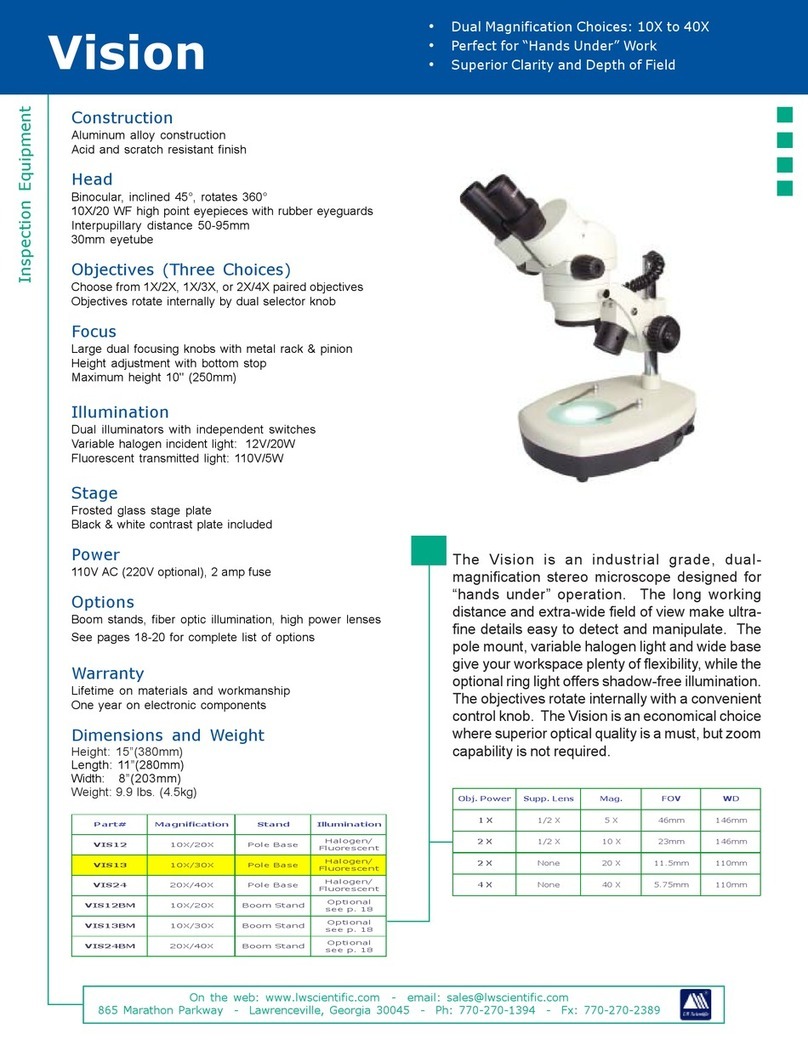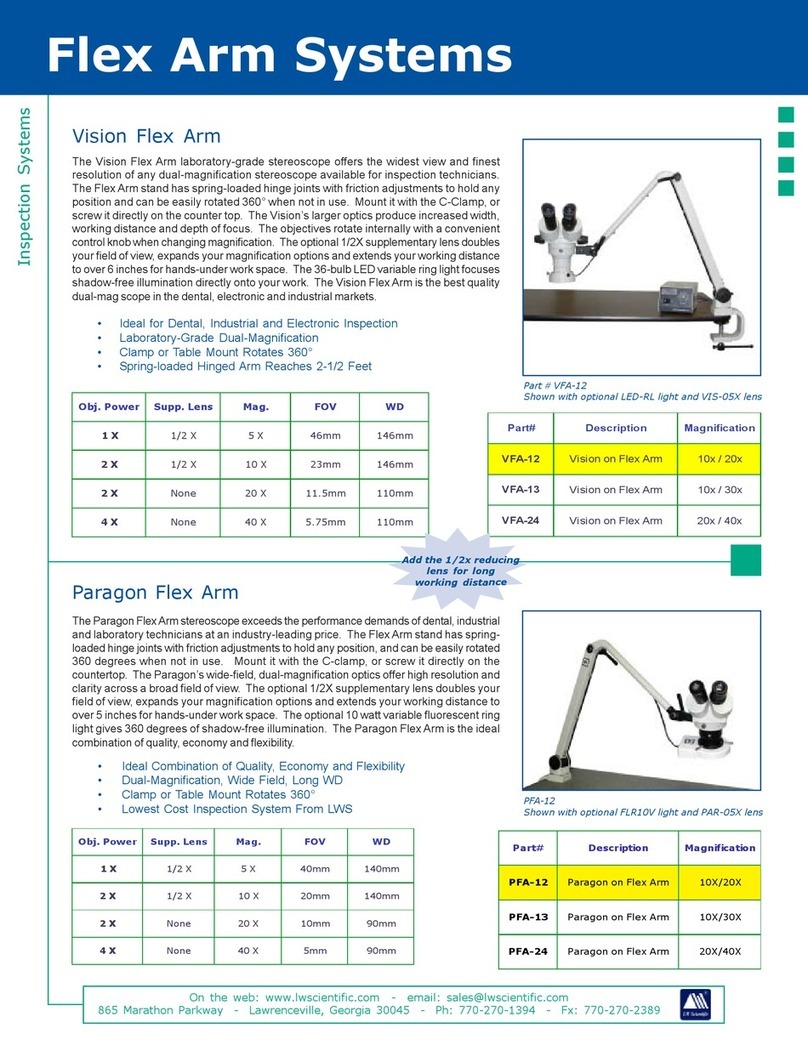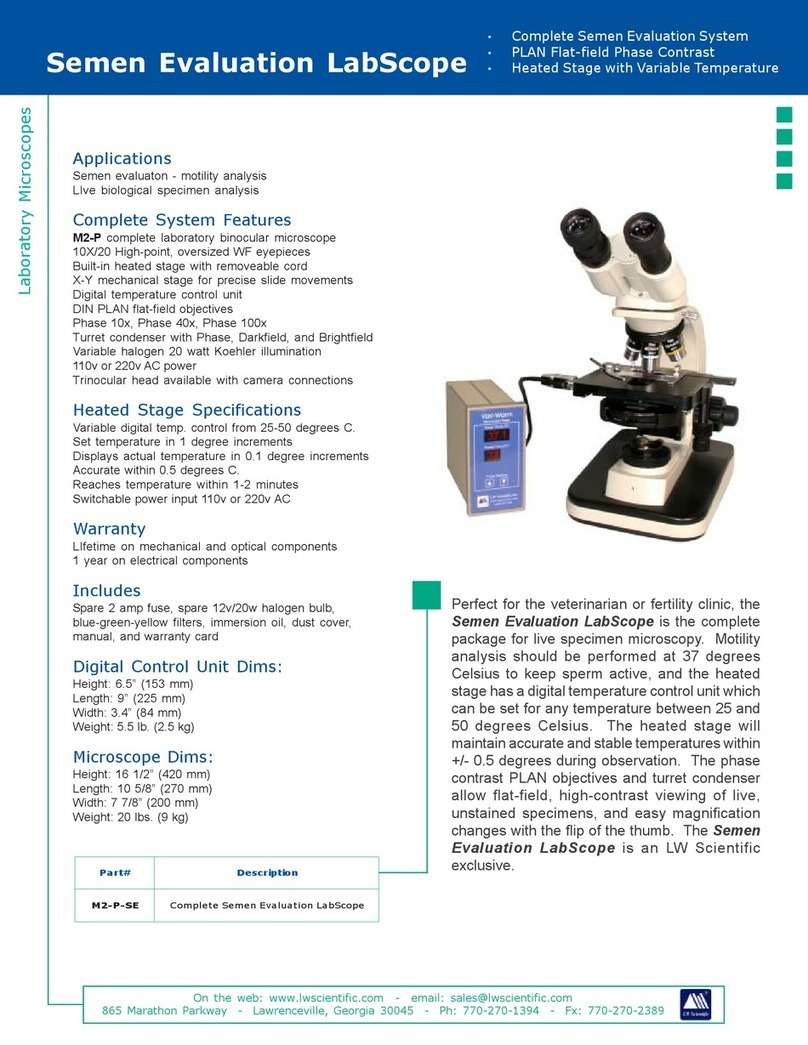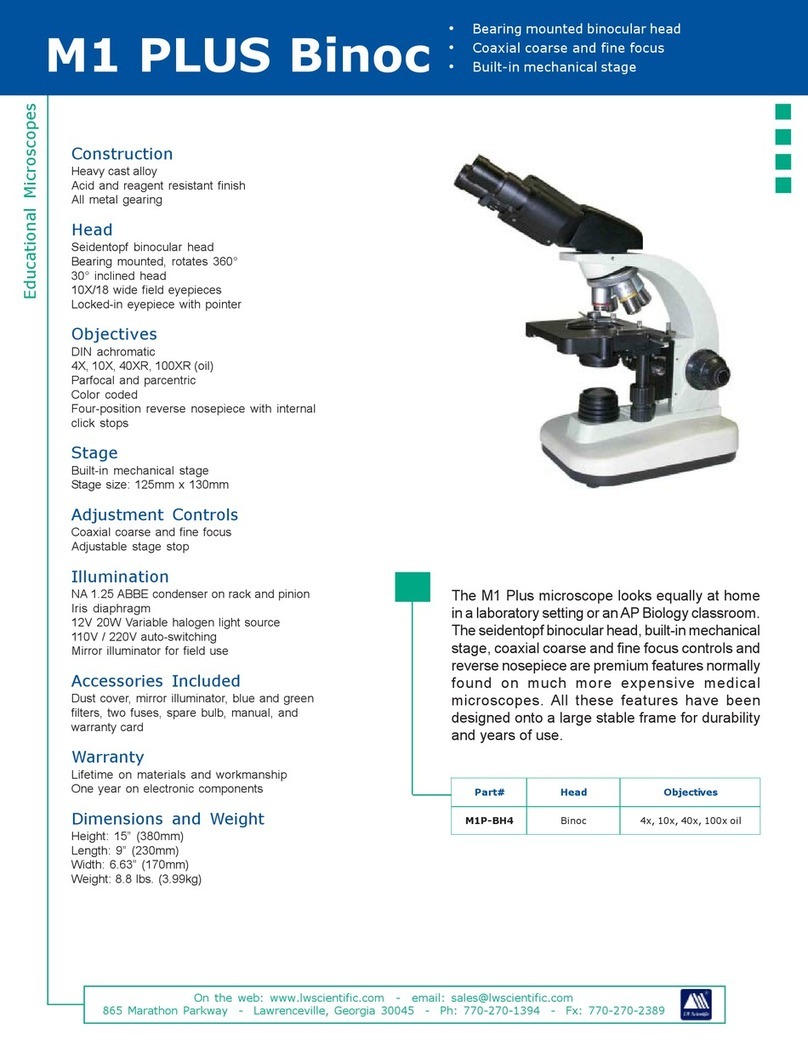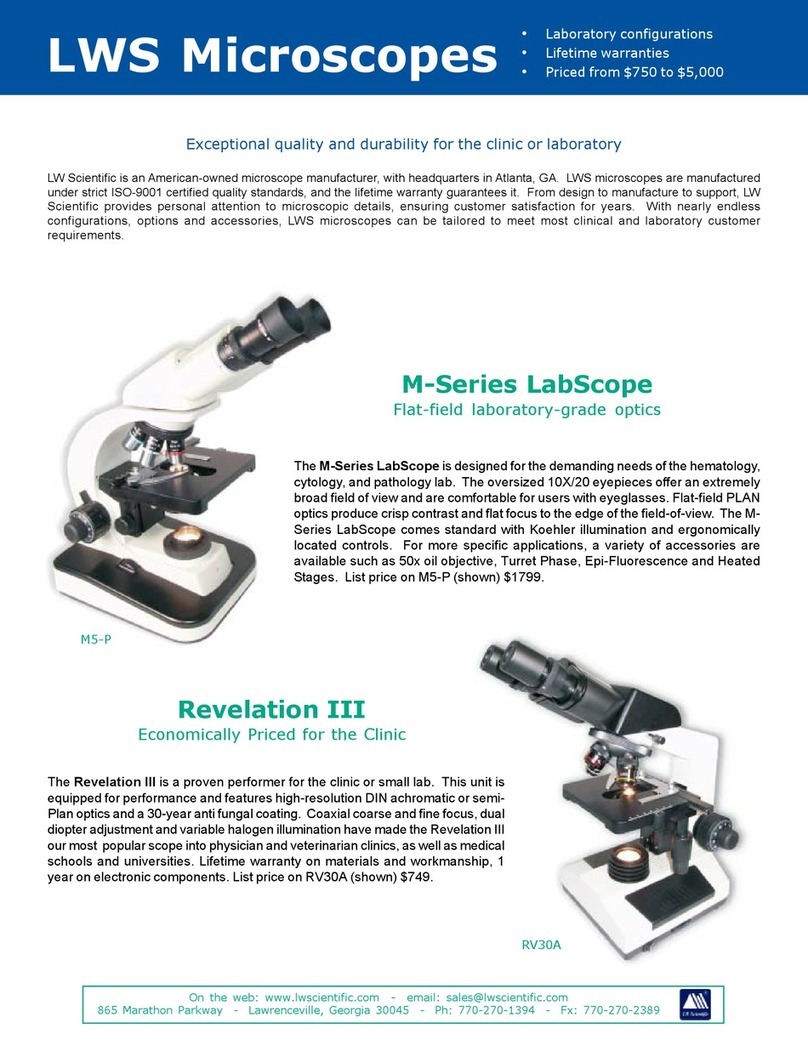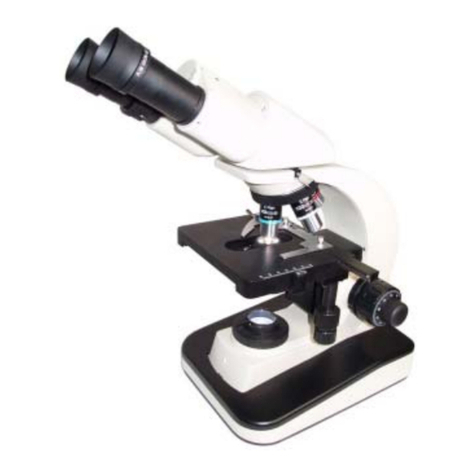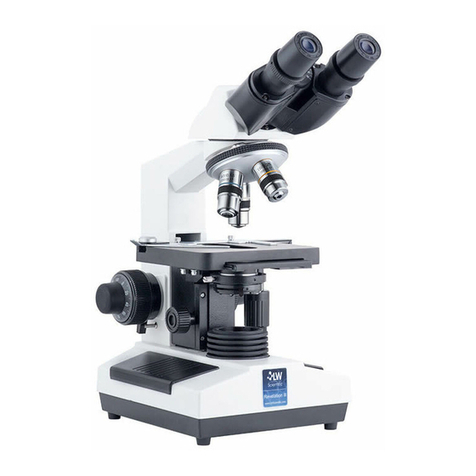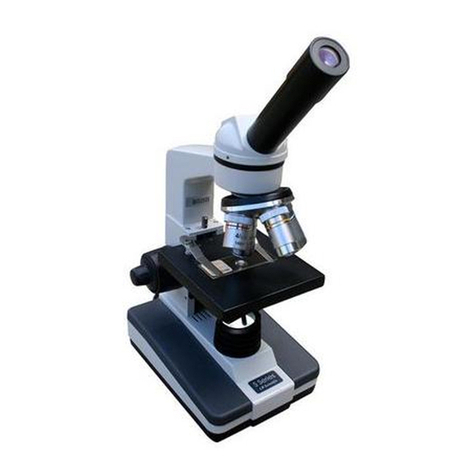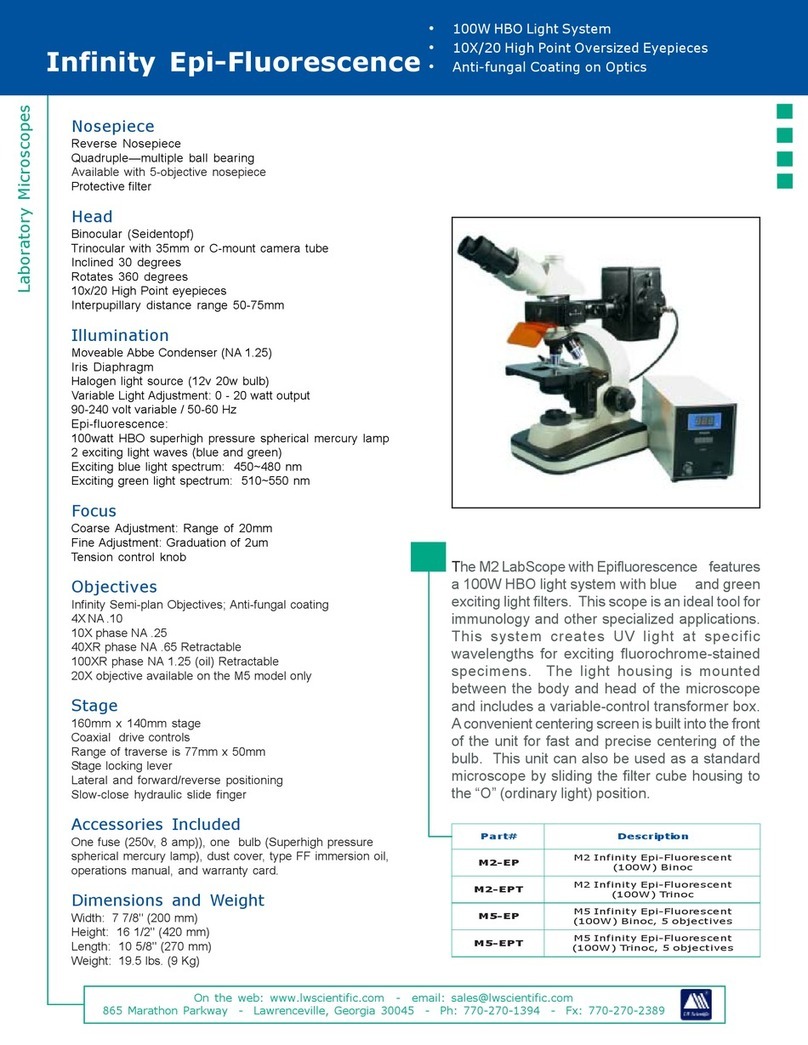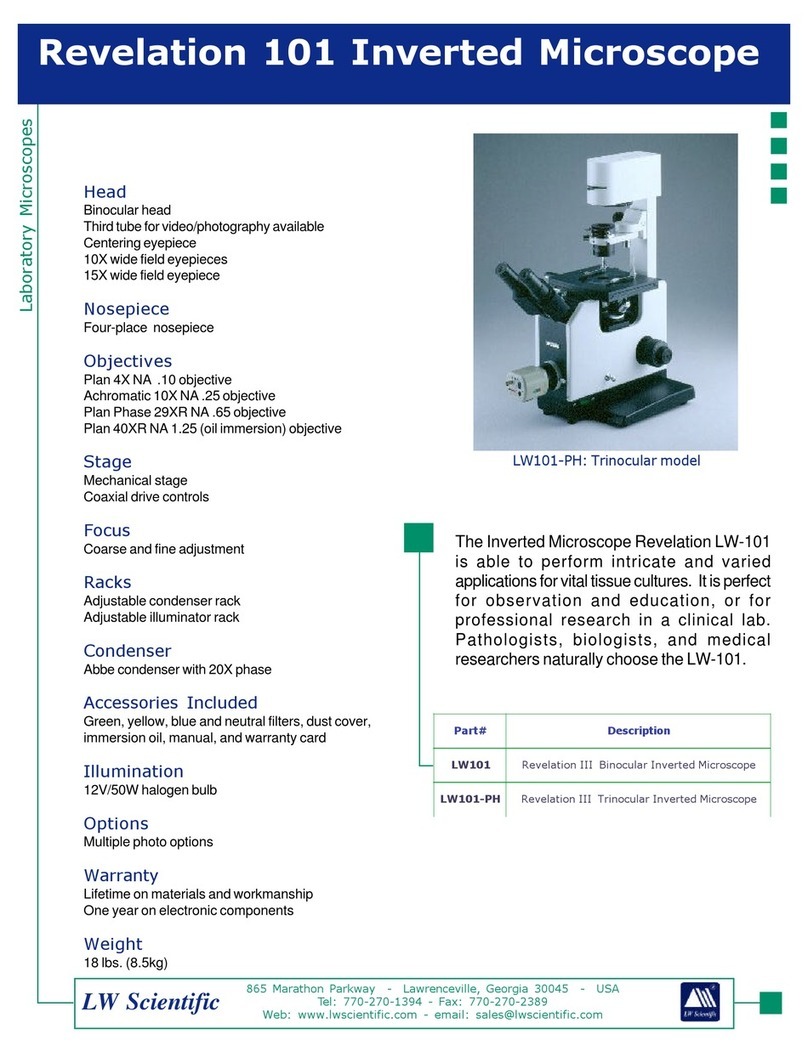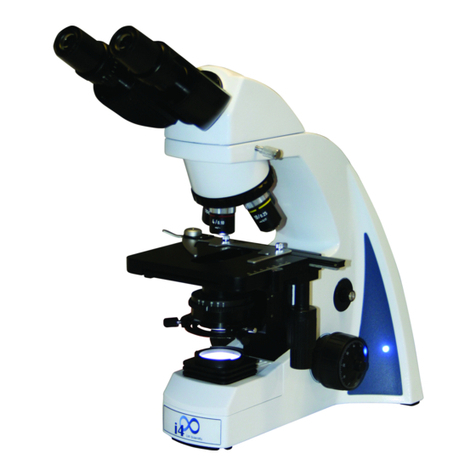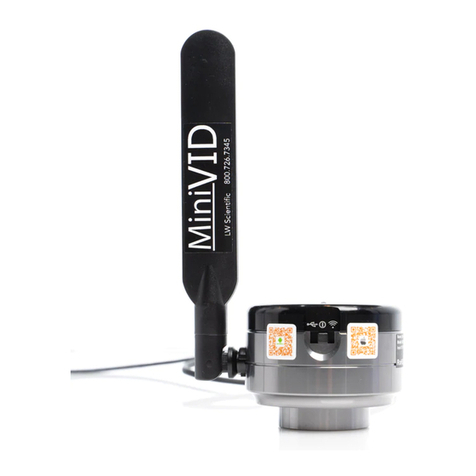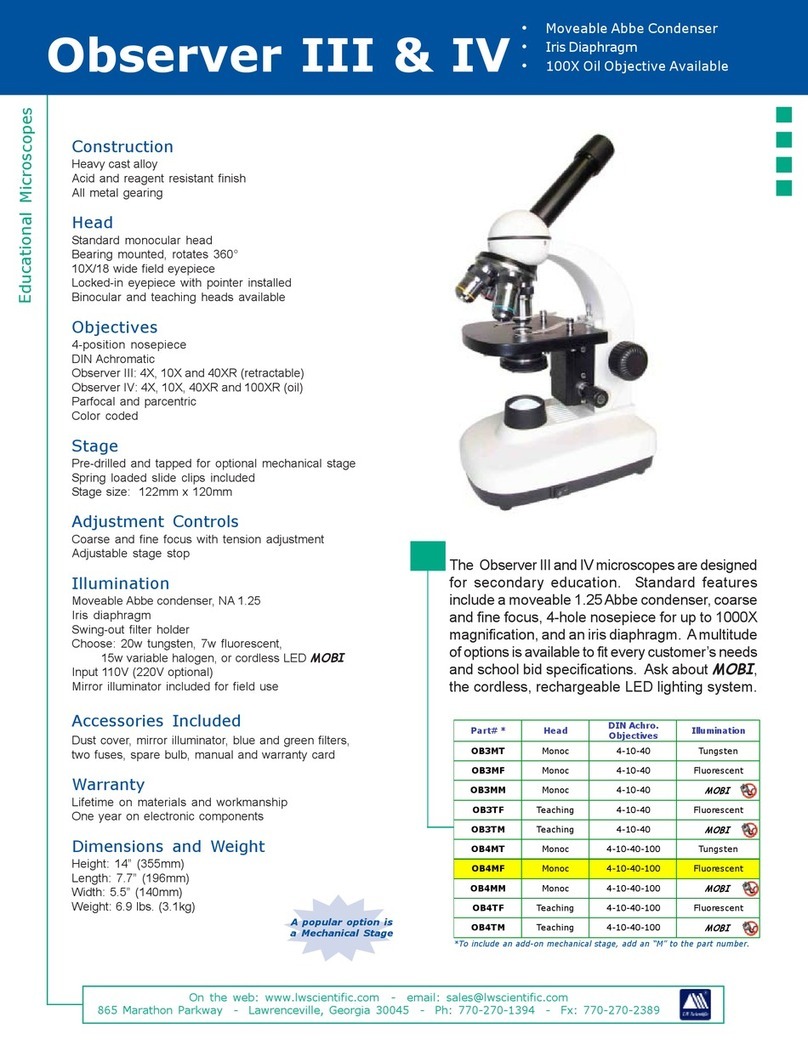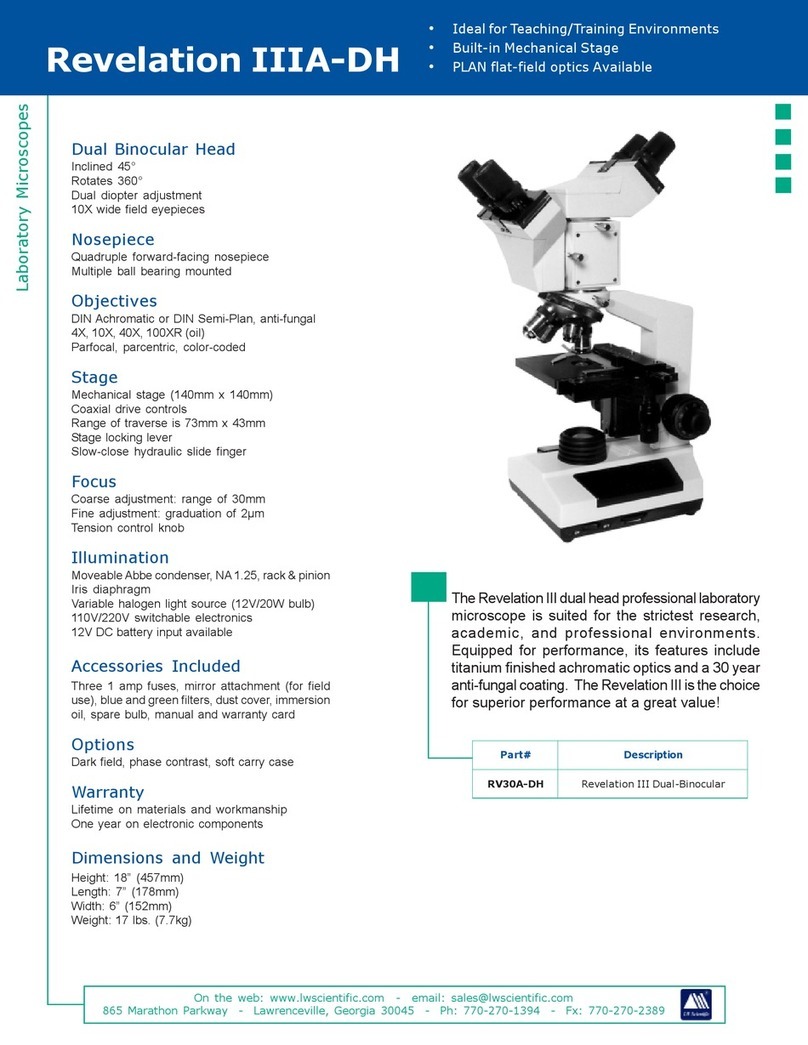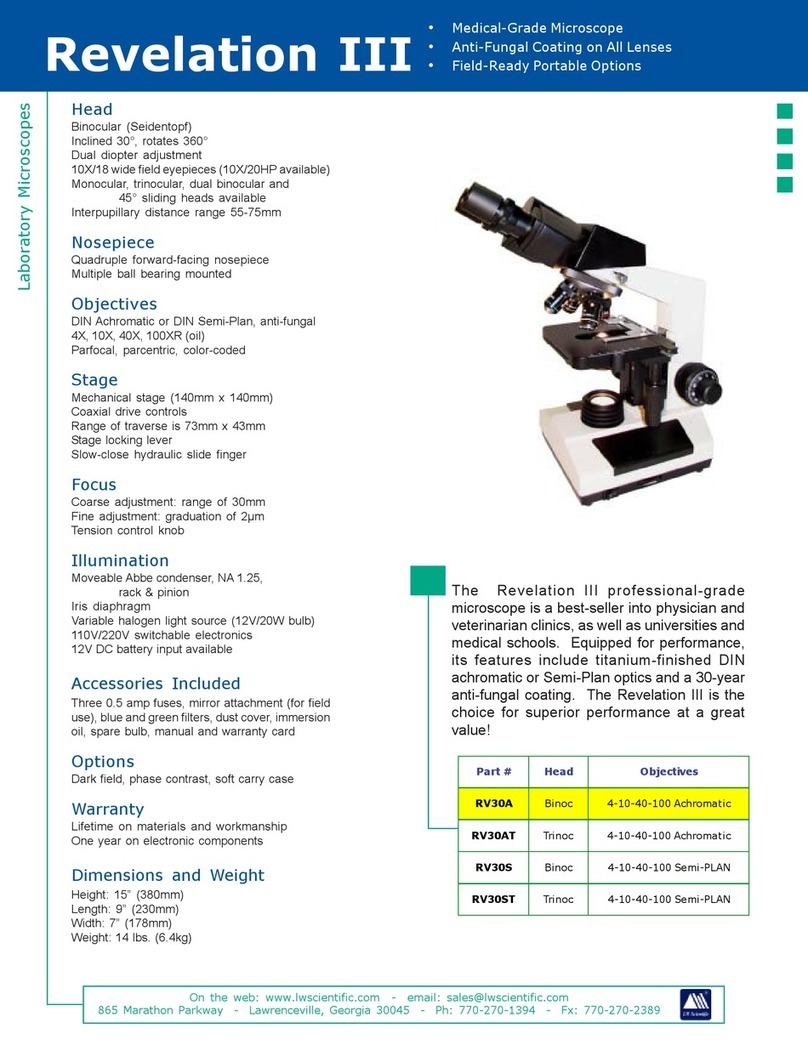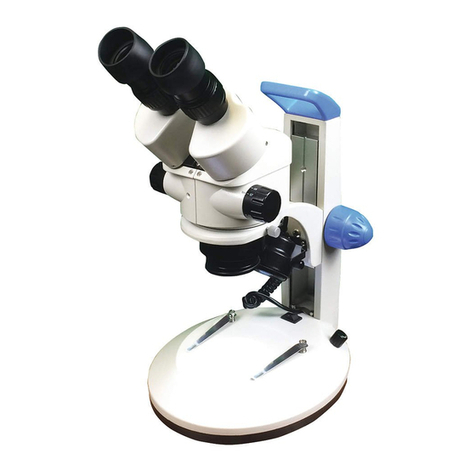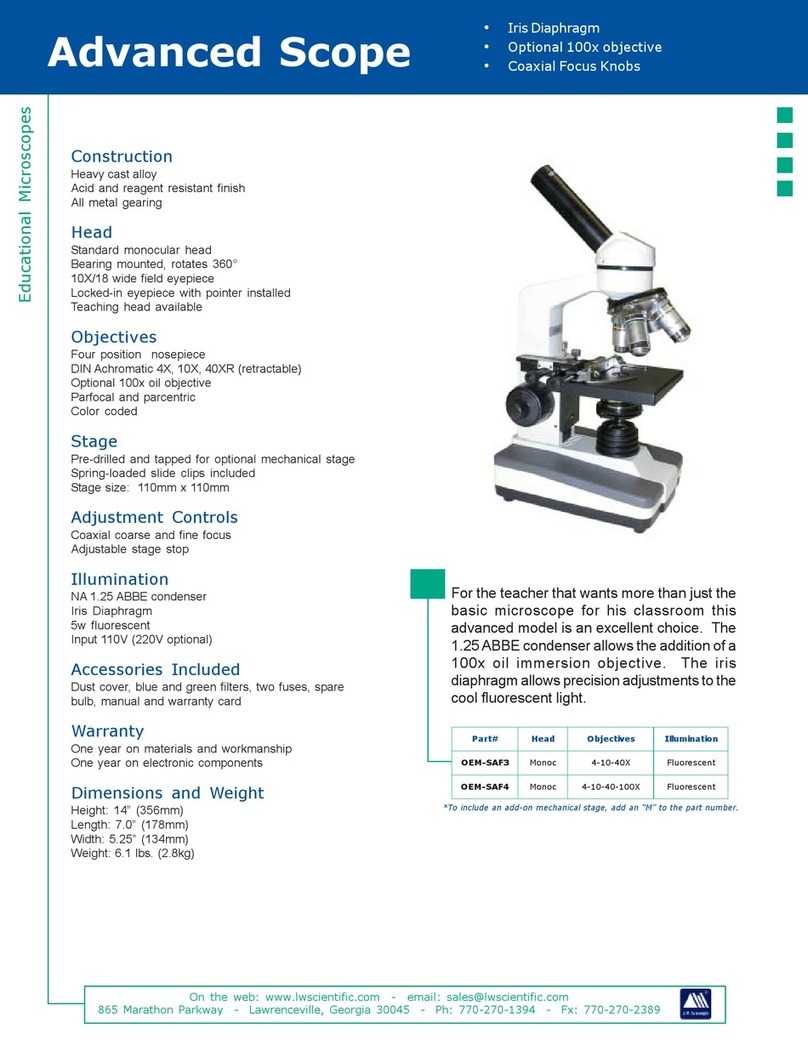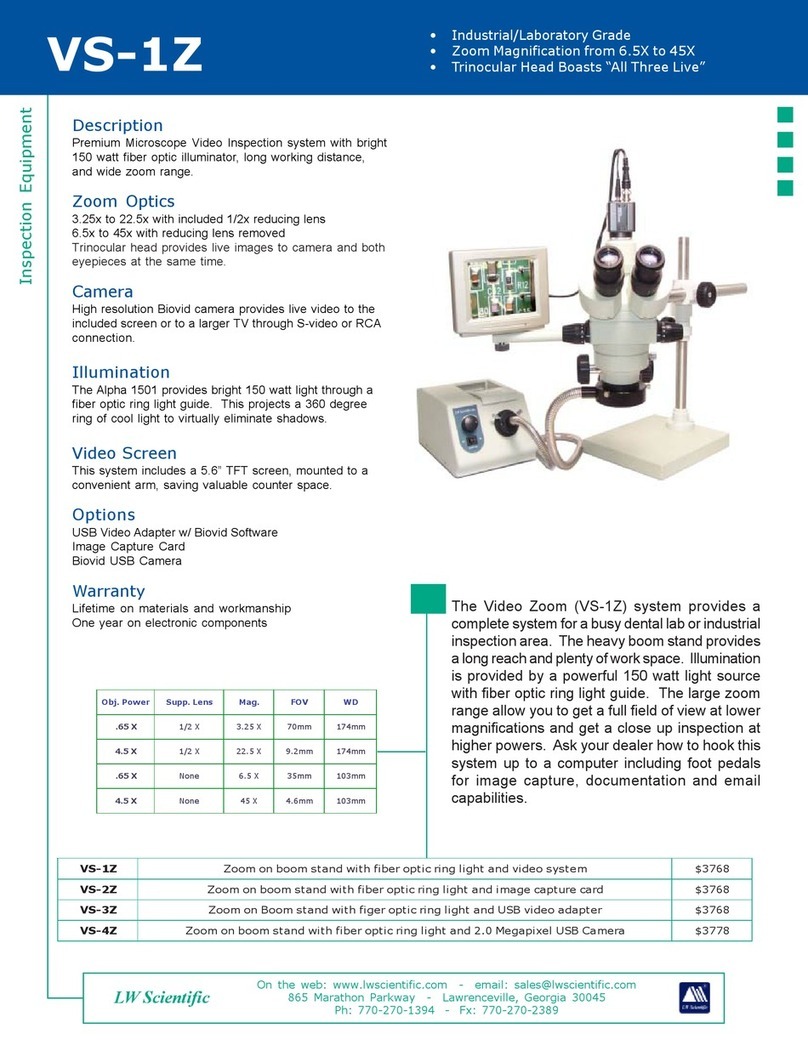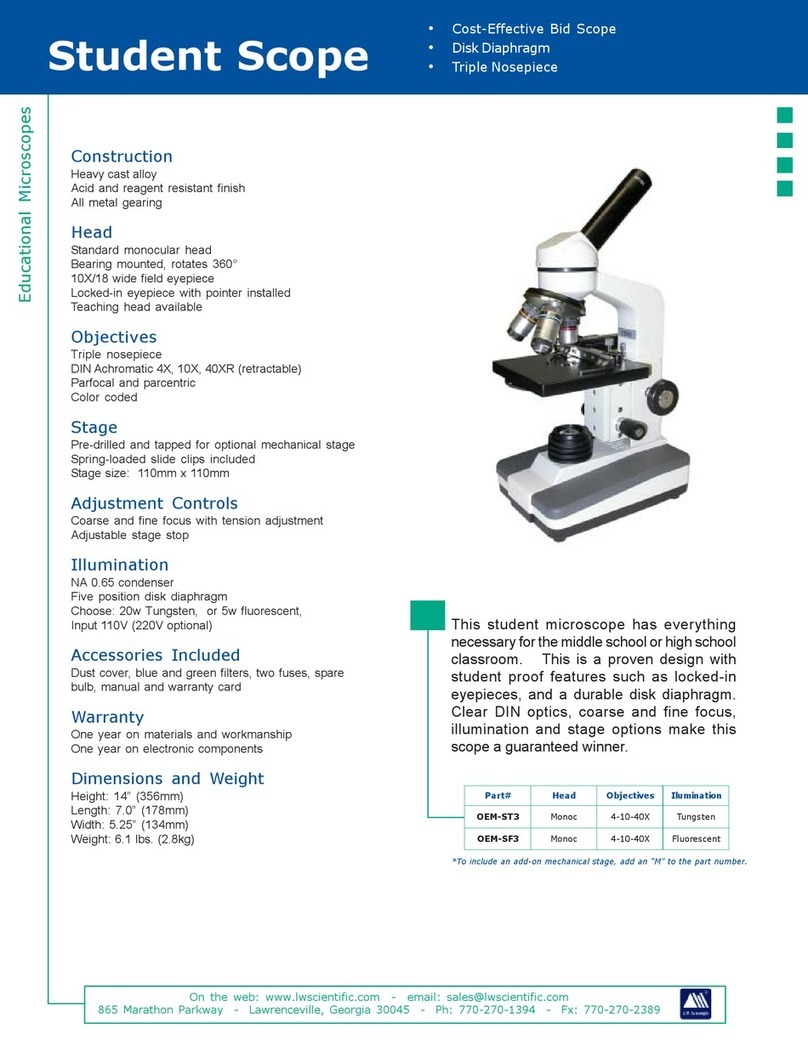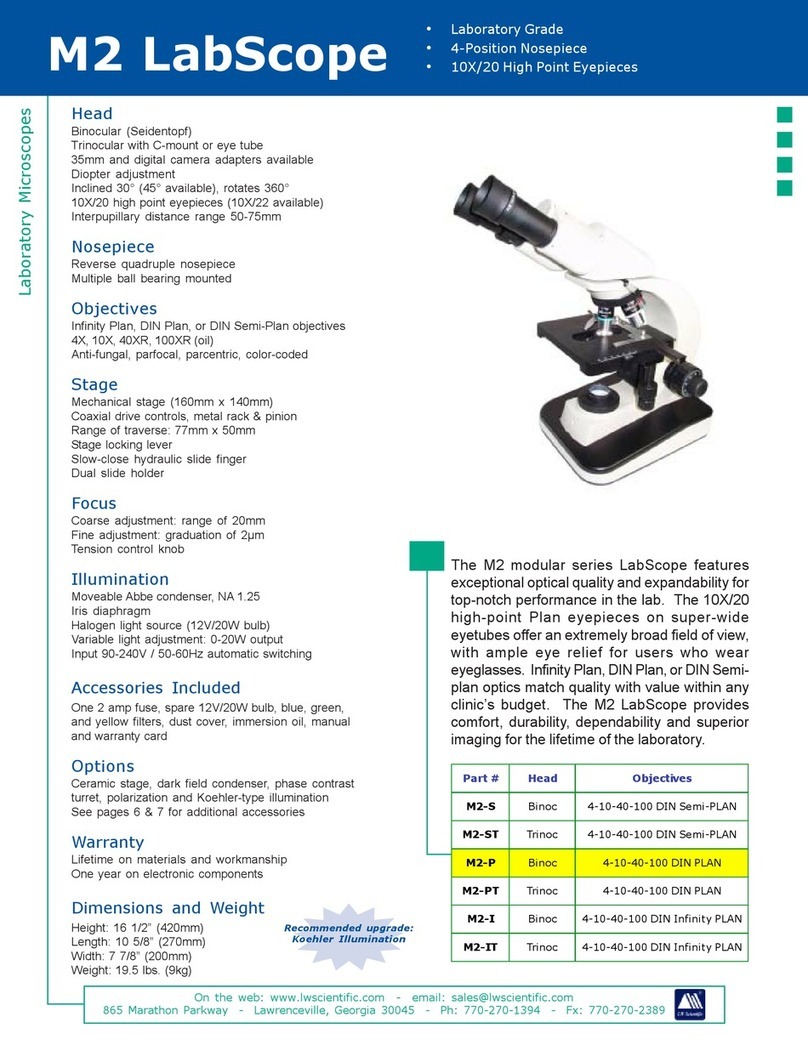P. 770.270.1394 F. 770.270.2389 865 Marathon Parkway Lawrenceville GA 30045
Unpacking and Setup
Assembly
Operation
LW Scientific packs each Revelation III Microscope with utmost care.
Examine the outer and inner containers for any visual damage. Retain all of
the packing material until you have examined and tested your new
microscope. If there is damage, please contact the shipping company, as
our warranty does not cover shipping damage. If you are uncertain who the shipper is, contact the distributor from whom
you purchased the microscope. Please retain all packaging material for future use. Carefully unpack** your Revelation III
Microscope using the following checklist for all the parts and accessories:
1 - Microscope body with Abbe condenser
2 - 10x eyepieces
1 - Binocular head (Seidentopf style)
1 - Mirror and attachment device for field use
2 - Filters (blue & green)
4 - Objectives 4X, 10XR, 40XR, 100XR (oil)
1 - Power Adapter
1 - Warranty Card
1 - Immersion oil
1 - Dust cover
**Note: Some parts may be packed in the
outer recesses of the Styrofoam blocks
Power
2
5
3
1Remove the body of the microscope and place it on a sturdy, dust-free surface. Remove the plastic plugs in the nose
piece. Install the objectives in such a way that when you turn the nosepiece clockwise, you are moving from the 4x,
Insert the 10x eyepieces.
Attach the power adapter.
4For protection during shipping your Rev III is shipped with the stage locked in low position. To disengage the lock,
pull the STAGE LOCK LEVER towards the rear and downward. The stage should now move upward freely.
Remove the microscope head from the Styrofoam carton and pull off the protective covers from the
eyepiece tubes and head mount. Insert the head mount into the upper arm of the body. Using the
head retention screw, secure the head in place. Note: Do not over-tighten.
1
2
3
4
5
6
7
8
9
10
11
Once you have assembled all the parts and allowed your microscope to come to room temperature, plug the
power adapter into the microscope and then into the appopriate AC outlet. Note: Excess cold can fog lenses
and cause lamp to fail.
Turn the light on using the black on/off switch on the right side of the base. Next adhust the light intensity using
the brightness control wheel located on the right side just behind the on/off switch.
In order to become acquainted with the controls, choose a specimen slide with which you are familiar. For
example, an old hematology slide or a commercially prepared slide. Place the slide into the slide holder by
pushing back on the thumb guard to open the slide finger. The slide finger closes slowly to eliminate the
possibility of chipping the corner of your slide when it closes.
Move the slide to the center of the stage, by turning the stage control knobs, located just below the stage.
These knobs allow yo to move the slide on the X-Y axis (forward/backward and left/right).
The sub-stage iris should then be set to match the aperture of the objective for maximum resolution under each
objective power. You should begin with the 4x or 10x objective.
4x objective 1.0 N.A. (nearly closed) 40x objective - 0.65 N.A. (halfway closed)
10x objective - 0.25 N.A. (1/4 closed) 100x objective - 1.25 N.A. (wide open)
Insert the filter of your choice into the swing-out filter holder beneath the Abbe condenser. Note that many
customers prefer to use the blue filter for routine use.
Once you are comfortably seated, look into the oculars and move the eyepiece tubes together or apart until
you see only one complete circle of light. You have now adjusted your interpupillary distance.
Using the 4x or 10x objectives and the coarse and fine adjustment knobs, bring the specimen into focus. Now,
move the 40x objective into place. You will feel a “clicking” action when the objective is seated properly.
Again, adjust focus for best image. You should also adjust the iris diaphragm (as listed above) for the best
contrast and resolution.
Diopter Adjustment: Since you are using a binocular microscope, you have to adjust the normal difference in
vision between your two eyes. This is a simple but critical adjustment! Close your left eye and look into the right
ocular with your right eye. Adjust the focus to give you the best image. Now look at the ocular tube on the left.
You will see that the left ocular tube has a built-in adjustment ring. Now close your right eye and look with your
left eye into the left ocular. Using the diopter adjustment ring on the left ocular tube, adjust the focus until you
see a clear, focused field.
Friction Adjustment: With repeated use and wear, the stage may drift out of focus. If this happens, you need
only to tighten the tension control ring (located on the right side of the microscope between the coarse
adjustment and the body of the microscope). If the coarse focus is hard to turn, you may choose to loosen the
friction adjustment.
Stage Stop Lever: To help prevent the stage from hitting the objectives, the Revelation III Microscope is
equipped with an adjustable stage stop. Rotate the 100x oil objective into place, and put a slide into the slide
holder. Slowly raise the stage, stopping when the slide makes contact with the objective. Now, turn the stage
stop lever in a clockwise direction toward you. The stage stop lever is located on the left side of the micro-
scope between the coarse adjustment and the body of the microscope.
If you suspect faulty electronics, call LW Scientific’s technical service department at 800-726-7345.
USE ONLY SUPPLIED POWER ADAPTER
Power Adapter:
Input: 90-240V / 50-60 Hz Auto-Switching
Output: 12V 1A
Microscope:
Input: 12V 1A
